|
|
|
Sort Order |
|
|
|
Items / Page
|
|
|
|
|
|
|
| Srl | Item |
| 1 |
ID:
178656
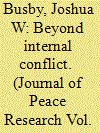

|
|
|
|
|
| Summary/Abstract |
The field of climate and security has matured over the past 15 years, moving from the margins of academic research and policy discussion to become a more prominent concern for the international community. The practice of climate and security has a broad set of concerns extending beyond climate change and armed conflict. Different national governments, international organizations, and forums have sought to mainstream climate security concerns emphasizing a variety of challenges, including the risks to military bases, existential risks to low-lying island countries, resource competition, humanitarian emergencies, shocks to food security, migration, transboundary water management, and the risks of unintended consequences from climate policies. Despite greater awareness of these risks, the field still lacks good insights about what to do with these concerns, particularly in ‘fragile’ states with low capacity and exclusive political institutions.
|
|
|
|
|
|
|
|
|
|
|
|
|
|
|
|
| 2 |
ID:
178652
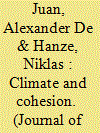

|
|
|
|
|
| Summary/Abstract |
While a large body of research has highlighted the conflict-inducing effects of climate change, we still know very little about the mechanisms linking environmental conditions to violent conflict. This article investigates the plausibility of a prominent channel according to which scarcity of natural resources can foster violent conflict through deteriorating intergroup relations. In addition to assessing the direct effects of adverse environmental conditions on intra-ethnic and inter-ethnic trust, we suggest a conditional argument on the role of horizontal inequality of hazard exposure. Environmental hazards are ‘unequal’ if they systematically affect ethnic groups differently. While inequality may reinforce intra-ethnic ties and out-group suspicion, equal hazard exposure may create a sense of unity among diverse victims in their collective struggle to cope with harsh environmental conditions. We test these arguments in the context of the severe drought periods that affected most East African countries in the years 2004 and 2005. The empirical analysis combines gridded information on drought severity with geo-located survey data across six countries in the region (Afrobarometer survey 2005/2006). Our main analyses find that exposure to drought hazards correlates positively with self-reported trust within and across ethnic groups. The latter association, however, depends on the degree of intergroup equality of hazard exposure and wanes as inequality increases. Taken together, these findings indicate that if droughts increase the risk of violent conflict, they seem to do so through mechanisms other than intergroup polarization and despite their positive association with ethnic trust. This is most likely the case in contexts where there is pronounced horizontal inequality of drought hazards.
|
|
|
|
|
|
|
|
|
|
|
|
|
|
|
|
| 3 |
ID:
178651
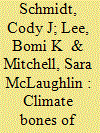

|
|
|
|
|
| Summary/Abstract |
Many scholars examine the relationship between climate variability and intrastate conflict onset. While empirical findings in this literature are mixed, we know less about how climate changes increase the risks for conflicts between countries. This article studies climate variability using the issue approach to world politics. We examine whether climate variability influences the onset and militarization of interstate diplomatic conflicts and whether these effects are similar across issues that involve sovereignty claims for land (territory) or water (maritime, river). We focus on two theoretical mechanisms: scarcity (abundance) and uncertainty. We measure these concepts empirically through climate deviation (e.g. droughts/floods, heat waves/cold spells) and climate volatility (greater short-term variance in precipitation/temperature). Analyses of issue claims in the Western Hemisphere and Europe (1901–2001) show that greater deviations and volatility in climate conditions increase risks for new diplomatic conflicts and militarization of ongoing issues and that climate change acts as a trigger for revisionist states.
|
|
|
|
|
|
|
|
|
|
|
|
|
|
|
|
| 4 |
ID:
178649
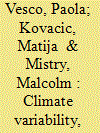

|
|
|
|
|
| Summary/Abstract |
Although substantive agreement exists on the role of climate variability and food scarcity in increasing violence, a limited number of studies have investigated how food resources affect violent conflict. This article explores the complex linkages between climate variability, agricultural production and conflict onset, by focusing on the spatial distribution of crop production in a cross-country setting. We hypothesize that spatial differences in crop production within countries are a relevant factor in shaping the impact of climate variability on conflict in agriculturally -dependent countries. To test this hypothesis, we rely on high-resolution global gridded data on the local yield of four main crops for the period 1982–2015 and aggregate the grid-cell information on crop production to compute an empirical indicator of the spatial concentration of agricultural production within countries. Our results show that the negative impacts of climate variability lead to an increase in the spatial concentration of agricultural production within countries. In turn, the combined effect of climate extremes and crop production concentration increases the predicted probability of conflict onset by up to 14% in agriculturally dependent countries.
|
|
|
|
|
|
|
|
|
|
|
|
|
|
|
|
| 5 |
ID:
178644
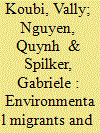

|
|
|
|
|
| Summary/Abstract |
The displacement of people due to climatic changes (environmental migration) presents major societal and governance challenges. This article examines whether and how climate-induced rural-to-urban migration contributes to social-movement participation. We argue that the mainly forceful nature of relocation makes environmental migrants more likely to join and participate in social movements that promote migrant rights in urban areas. Using original survey data from Kenya, we find that individuals who had experienced several different types of severe climatic events at their previous location are more likely to join and participate in social movements. This finding has important policy implications. National and local authorities should not only provide immediate assistance and basic social services to environmental migrants in urban settings, but also facilitate permanent solutions by fostering their socio-economic and political integration in order to prevent urban conflict.
|
|
|
|
|
|
|
|
|
|
|
|
|
|
|
|
| 6 |
ID:
178648


|
|
|
|
|
| Summary/Abstract |
Disasters triggered by natural hazards will increase in the future due to climate change, population growth, and more valuable assets located in vulnerable areas. The impacts of disasters on political conflict have been the subject of broad academic and public debates. Existing research has paid little attention to the links between climate change, disasters, and small-scale conflicts, such as protests or riots. Floods are particularly relevant in this context as they are the most frequent and most costly contemporary disasters. However, they remain understudied compared to other disasters, specifically, droughts and storms. We address these gaps by focusing on flood-related political unrest between 2015 and 2018 in Africa, Asia, and the Middle East. Drawing on data from the Dartmouth Flood Observatory (DFO) and Armed Conflict Location and Event Dataset (ACLED), we find that flood-related political unrest occurs within two months after 24% of the 92 large flooding events recorded in our sample. Subsequently, a qualitative comparative analysis (QCA) shows that the simultaneous presence of a large population, a democratic regime, and either the exclusion of ethnic groups from political power or a heavy impact of the flood is an important scope condition for the onset of flood-related political unrest. This indicates that disaster–conflict links are by no means deterministic. Rather, they are contingent on complex interactions between multiple contextual factors.
|
|
|
|
|
|
|
|
|
|
|
|
|
|
|
|
| 7 |
ID:
178647
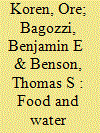

|
|
|
|
|
| Summary/Abstract |
Research often fails to account for the specific pathways by which climatic factors can cause social unrest. One challenge lies in understanding the distinct effects of food insecurity and water insecurity – which we term ‘staple insecurities’ – while accounting for their interrelated nature, especially at high-resolution spatio-temporal scales. To unpack these dynamics, we leverage geolocated Twitter data across urban areas in Kenya and deploy a supervised machine learning approach to separately identify geolocated tweets concerning food and water insecurity, in both English and Swahili. The data are then aggregated to create daily measures of food and water insecurity for standardized grid-cells to examine how perceived food insecurity moderates and/or reinforces perceived water insecurity’s impacts on social unrest, and vice versa. Our findings suggest that food and water insecurities’ respective effects should be interpreted as mutually reinforcing – in compelling citizens to take to the streets – rather than as independent. Those concerned with climate change’s impact on conflict should hence endeavor to jointly account for both forms of insecurity, and their interactive effects.
|
|
|
|
|
|
|
|
|
|
|
|
|
|
|
|
| 8 |
ID:
178646
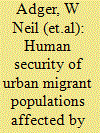

|
|
|
|
|
| Summary/Abstract |
It is widely suggested that migration is a key mechanism linking climate change to violent conflict, particularly through migration increasing the risks of conflict in urban destinations. Yet climate change also creates new forms of insecurity through distress migration, immobility and vulnerability that are prevalent in urban destination locations. Here we examine the extent and nature of human security in migration destinations and test whether insecurity is affected by length of residence and environmental hazards. The study develops an index measure of human security at the individual level to include environmental and climate-related hazards as well as sources of well-being, fear of crime and violence, and mental health outcomes. It examines the elements of human security that explain the prevalence of insecurity among recent and established migrants in low-income urban neighbourhoods. The study reports on data collected in Chattogram in Bangladesh through a survey of migrants (N = 447) and from qualitative data derived using photo elicitation techniques with cohorts of city planners and migrants. The results show that environmental hazards represent an increasing source of perceived insecurity to migrant populations over time, with longer-term migrants perceiving greater insecurity than more recent arrivals, suggesting lack of upward social mobility in low-income slums. Ill-health, fear of eviction, and harassment and violence are key elements of how insecurity is experienced, and these are exacerbated by environmental hazards such as flooding. The study expands the concept of security to encompass central elements of personal risk and well-being and outlines the implications for climate change.
|
|
|
|
|
|
|
|
|
|
|
|
|
|
|
|
| 9 |
ID:
178645
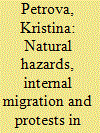

|
|
|
|
|
| Summary/Abstract |
Does internal migration following natural hazards increase the likelihood of protests in migrant-receiving areas? To address the question, this study first looks at the extent to which experiencing different forms of natural hazards contributes to a household’s decision to leave their district of residence. In a second step, the article explores whether that internal migration flow increases the number of protest events in migrant-hosting districts. In doing so, it contributes to the existing debate on the extent to which natural hazards impact the likelihood of social contention, and the role of migration as a linking pathway in that relationship. The impact of climate-related shocks may erode household assets and therefore adaptive capacity in ways that can eventually influence decisions to migrate to larger urban centres. Although migrants are agents of economical and technological change, urban environments may impose challenges to recently arrived migrants and their host communities, affecting the motivations and mobilization resources of urban social groups to protest. As a consequence, the probability of urban unrest in these locations is expected to increase. To test this, I use geo-referenced household-level data from Bangladesh for the period 2010–15, which records households’ experiences of different forms of natural hazard and internal migration flows, available from the Bangladesh Integrated Household Survey. It combines this with data on protests, derived from the Armed Conflict Location and Event Data. Findings suggest that flood hazards in combination with loss of assets increase the likelihood of internal migration, but unlike other types of domestic mobility, hazard-related migration does not increase the frequency of protests in migrants’ districts of destination.
|
|
|
|
|
|
|
|
|
|
|
|
|
|
|
|
| 10 |
ID:
178653


|
|
|
|
|
| Summary/Abstract |
A large body of research now indicates that climate likely matters for conflict. This climate–conflict scholarship, however, has involved divergent findings, sometimes strident disagreement, and resulting limits to the usability of the scholarship for policymakers and practitioners. This viewpoint essay draws from recent expert assessments of climate–conflict linkages to position the research field among climate change research and assessment more broadly. We explore potential insights from the climate realm. As is often the case for climate change research, science–society dynamics are inherent in scholarship on climate and conflict. They contribute to contestation about the state of knowledge, the best ways to characterize it, and its implications for societal choices and investments. Our critique is grounded in the literature evaluating policy-relevant climate change assessment across diverse disciplines, from sea-level-rise adaptation science to energy-system modeling. Through comparisons with such fields, this perspective article considers several implications for climate–conflict knowledge production. We examine, in particular, the necessity of integrating diverse lines of evidence to understand the risks of responding to societally relevant uncertainties and priorities, and of encouraging interactions among researchers, practitioners, and policymakers. The experiences of other climate change disciplines can provide inspiration for potential directions for climate, conflict, and security scholarship. They include risk framings in integrating underlying evidence, through to options for supporting the interactions among researchers and societies.
|
|
|
|
|
|
|
|
|
|
|
|
|
|
|
|
| 11 |
ID:
178643
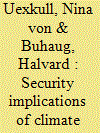

|
|
|
|
|
| Summary/Abstract |
The study of security implications of climate change has developed rapidly from a nascent area of academic inquiry into an important and thriving research field that traverses epistemological and disciplinary boundaries. Here, we take stock of scientific progress by benchmarking the latest decade of empirical research against seven core research priorities collectively emphasized in 35 recent literature reviews. On the basis of this evaluation, we discuss key contributions of this special issue. Overall, we find that the research community has made important strides in specifying and evaluating plausible indirect causal pathways between climatic conditions and a wide set of conflict-related outcomes and the scope conditions that shape this relationship. Contributions to this special issue push the research frontier further along these lines. Jointly, they demonstrate significant climate impacts on social unrest in urban settings; they point to the complexity of the climate–migration–unrest link; they identify how agricultural production patterns shape conflict risk; they investigate understudied outcomes in relation to climate change, such as interstate claims and individual trust; and they discuss the relevance of this research for user groups across academia and beyond. We find that the long-term implications of gradual climate change and conflict potential of policy responses are important remaining research gaps that should guide future research.
|
|
|
|
|
|
|
|
|
|
|
|
|
|
|
|
| 12 |
ID:
178654


|
|
|
|
|
| Summary/Abstract |
Warning about dire effects of climate change on armed conflict is a recent variation of a scenario that has been promoted by environmental pessimists for over two centuries. The essence is that human activities lead to resource scarcities that in turn will generate famine, pestilence, and war. This essay reviews three stages of the argument: first, the original Malthusian thesis that focused on food production. Second, the broader neoMalthusian concern from the 1970s about limits to growth and developing scarcities in a range of necessities. And recently, the specter of climate change. In each phase, the Malthusians have met firm opposition from environmental optimists, who argue that emerging scarcities can be countered by human ingenuity, technological progress, and national and international economic and political institutions and that environmental change is not in itself a major driver of human violence. In the third phase, the Malthusian case appears to be stronger because human activities have reached a level where they have a truly global impact. Environmental optimists still insist that these problems can be overcome by human ingenuity and that the long-term trend towards less violence in human affairs is unlikely to be reversed by climate change. The stakes seem higher, but the structure of the debate remains largely the same.
|
|
|
|
|
|
|
|
|
|
|
|
|
|
|
|
| 13 |
ID:
178650
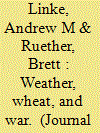

|
|
|
|
|
| Summary/Abstract |
We examine how Syria’s local growing seasons and precipitation variability affected patterns of violence during the country’s civil war (2011–19). Among Syria’s 272 subdistricts (nahiyah), we study conflict events initiated by the Assad regime or its allies, and, separately, by other armed non-government groups (‘rebels’). Throughout the war, violence to capture agriculture has been used regularly to control valuable cropland and harvests. Combatants also seek to deny their adversaries access to these resources by deploying violence to destroy agriculture. We test the hypothesis that conflict was most likely during local growing seasons due to both of these motivations. Additionally, we examine whether unusually dry conditions further elevated the risk of conflict during growing season months. A theory for why higher levels of conflict would occur during unusually dry conditions is that livelihood losses elevate incentives to control scarce crops and also facilitate recruitment of militants or their sympathizers. We find that violent events initiated by the government and rebel groups are both more likely during the growing season than other times of the year. There is also evidence that dry conditions during the growing season led to an increase in government-initiated attacks over the duration of the war. We find the strongest relationship between precipitation deficits and both government- and rebel-initiated violence in later years of the war. Compared with our growing season results, the rainfall deviation estimates are less consistent across models.
|
|
|
|
|
|
|
|
|
|
|
|
|
|
|
|
|
|
|
|
|